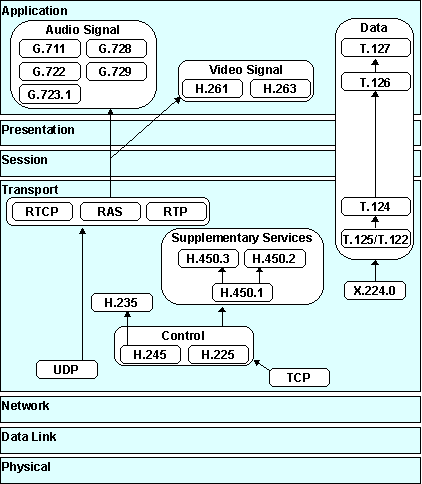 |
| ||||||||
 |
 |
 |
 |
 |
|
The H.323 standard provides a foundation for audio, video, and data communications across IP-based networks, including the Internet. H.323 is an umbrella recommendation from the International Telecommunications Union (ITU) that sets standards for multimedia communications over Local Area Networks (LANs) that do not provide a guaranteed Quality of Service (QoS). These networks dominate today’s corporate desktops and include packet-switched TCP/IP and IPX over Ethernet, Fast Ethernet and Token Ring network technologies. Therefore, the H.323 standards are important building blocks for a broad new range of collaborative, LAN-based applications for multimedia communications. It includes parts of H.225.0 - RAS, Q.931, H.245 RTP/RTCP and audio/video codecs, such as the audio codecs (G.711, G.723.1, G.728, etc.) and video codecs (H.261, H.263) that compress and decompress media streams. Media streams are transported on RTP/RTCP. RTP carries the actual media and RTCP carries status and control information. The signalling is transported reliably over TCP. The following protocols deal with signalling:
H.323 protocols in relation to the OSI model
RFC 1889: http://www.cis.ohio-state.edu/htbin/rfc/rfc1889.html The Real-time Transport (RTP) Protocol provides end-to-end network transport functions suitable for applications transmitting real-time data such as audio, video or simulation data, over multicast or unicast network services. RTP does not address resource reservation and does not guarantee quality-of-service for real-time services. The data transport is augmented by a control protocol (RTCP) to allow monitoring of the data delivery in a manner scalable to large multicast networks, and to provide minimal control and identification functionality. RTP and RTCP are designed to be independent of the underlying transport and network layers. The protocol supports the use of RTP-level transla tors and mixers. The format of the RTP Fixed Header Fields is shown in the following illustration:
RTP fixed header fields V P X CSRC
count M Payload
type Sequence
number Timestamp SSRC CSRC RFC 1889: http://www.cis.ohio-state.edu/htbin/rfc/rfc1889.html The RTP control protocol (RTCP) is based on the periodic transmission of control packets to all participants in the session, using the same distribution mechanism as the data packets. The underlying protocol must provide multiplexing of the data and control packets, for example using separate port numbers with UDP. The format of the header is shown in the following illustration:
RTCP structure Version P Reception
report count Length H.225: http://www.itu.int/itudoc/itu-t/rec/h/h225-0.html The Registration, Admission and Status (RAS) channel is used to carry messages used in the gatekeeper discovery and endpoint registration processes which associate an endpoint's alias address with its call signalling channel transport address. The RAS channel is an unreliable channel. Since the RAS messages are transmitted on an unreliable channel, H.225.0 recommends time-outs and retry counts for various messages. An endpoint or gatekeeper which cannot respond to a request within the specified timeout may use the Request in Progress (RIP) message to indicate that it is still processing the request. An endpoint or gatekeeper receiving the RIP resets its timeout timer and retry counter.
H.225: http://www.itu.int/itudoc/itu-t/rec/h/h225-0.html H.225.0 v2 is a standard which covers narrow-band visual telephone services defined in H.200/AV.120-Series Recommendations. It specifically deals with those situations where the transmission path includes one or more packet based networks, each of which is configured and managed to provide a non-guaranteed Quality of Service (QoS) which is not equivalent to that of N-ISDN such that additional protection or recovery mechanisms beyond those mandated by Rec. H.320 is necessary in the terminals. H.225.0 describes how audio, video, data, and control information on a packet based network can be managed to provide conversational services in H.323 equipment. The structure of H.225 follows the Q.931 standard as shown in the following illustration:
Q.931 header structure Protocol discriminator Length of call reference value Call reference value Message Type Other information elements
H.245:http://www.itu.int/itudoc/itu-t/rec/h/h245.html H.245 is line transmission of non-telephone signals. It includes receiving and transmitting capabilities as well as mode preference from the receiving end, logical channel signalling, and Control and Indication. Acknowledged signalling procedures are specified to ensure reliable audiovisual and data communication. H.245 messages are in ASN.1 syntax. They consist of an exchange of messages. MultimediaSystemControlMessage message types can be defined as request, response, command and indication messages. The following additional message sets are available:
H.261: http://www.cis.ohio-state.edu/htbin/rfc/rfc2032.html H.261 describes a video stream for transport using the real-time transport protocol, RTP, with any of the underlying protocols that carry RTP. The format of the header is shown in the following illustration:
H.261 header structure SBIT EBIT I V GOBN MBAP QUANT HMVD VMVD
RFC2190 (RTP): http://www.cis.ohio-state.edu/htbin/rfc/rfc2190.html H.263 specifies the payload format for encapsulating an H.263 bitstream in the Real-Time Transport Protocol (RTP). Three modes are defined for the H.263 payload header. An RTP packet can use one of the three modes for H.263 video streams depending on the desired network packet size and H.263 encoding options employed. The shortest H.263 payload header (mode A) supports fragmentation at Group of Block (GOB) boundaries. The long H.263 payload headers (modes B and C) support fragmentation at Macroblock (MB) boundaries. For each RTP packet, the RTP fixed header is followed by the H.263 payload header, which is followed by the standard H.263 compressed bitstream. The size of the H.263 payload header is variable depending on the modes. The layout of an RTP H.263 video packet is shown as:
RTP H.263 video packet Three formats (mode A, mode B and mode C) are defined for the H.263 payload header. In mode A, an H.263 payload header of four bytes is present before the actual compressed H.263 video bitstream. It allows fragmentation at GOB boundaries. In mode B, an 8-byte H.263 payload header is used and each packet starts at MB boundaries without the PB-frames option. Finally, a 12-byte H.263 payload header is defined in mode C to support fragmentation at MB boundaries for frames that are coded with the PB-frames option. The mode of each H.263 payload header is indicated by the F and P fields in the header. Packets of different modes can be intermixed. The format of the header for mode A is shown in the following illustration:
H.263 mode A payload header structure F P SBIT EBIT SRC I U S A R DBQ TRB TR The format of the header for mode B is shown here:
H.263 mode B payload header structure F, P, SBIT, EBIT, SRC, I, U, S and A are defined the same as in mode A. QUANT GOBN MBA R HMV1, VMV1 HMV2, VMV2 The format of the header for mode C is shown here:
H.263 mode C payload header structure F, P, SBIT, EBIT, SRC, I, U, S, A, DBQ, TRB and TR are defined the same as in mode A. QUANT, GOBN, MBA, HMV1, VMV1, HMV2, VNV2 are defined the same as in mode B. RR
H.235: http://www.itu.int/itudoc/itu-t/rec/h/h235.html H.235 provides enhancements within the framework of the H.3xx-Series Recommendations to incorporate security services such as Authentication and Privacy (data encryption). H.235 should work with other H series protocols that utilize H.245 as their control protocol. All H.235 messages are encrypted as in ASN.1. The H.45o series defines Supplementary Services for H.323, namely Call Transfer and Call Diversion. The H.450.1 protocol deals with the procedures and signalling protocol between H.323 entities for the control of supplementary services. This signalling protocol is common to all H.323 supplementary services. The protocol is derived from the generic functional protocol specified in ISO/IEC 11582 for Private Integrated Services Networks (PISN). The H.450 protocol is used to exchange signalling information to control supplementary services over a LAN. It works together with the H.225 protocol. This protocol has no header as all messages are in text, in ASN.1 format. This is a Call Transfer supplementary service for H.323. The H.450.2 protocol describes the procedures and signalling protocol for the call transfer supplementary service in H.323 networks. This supplementary service allows the served user A to transform an existing call (from user A to B) to a new call between user B and a third user C selected by A. User A may or may not have a call established with the third user prior to the call transfer. This is based on H.450.1 This protocol has no header as all messages are in text, in ASN.1 format. The H.450.3 is a call diversion supplementary service for H.323. It describes the procedures and signalling protocol for the call diversion supplementary service in H.323 networks. This includes the services Call Forwarding Unconditional (SS-CFU), Call Forwarding Busy (SS-CFB), Call Forwarding No Reply (SS-CFNR) and Call Deflection (SS-CD). These are all supplementary services, which apply during call establishment, providing a diversion of an incoming call to another destination endpoint. This is based on H.450.1 This protocol has no header as all messages are in text, in ASN.1 format. The T.38 IP-based fax service maps the T.30 fax protocol onto an IP network. Both fax and voiced data are managed through a single gateway. T.38 uses 2 protocols, one for UDP packets and one for TCP packets. Data is encoded using ASN.1 to ensure a standard technique. It allows users to transfer facsimile documents between 2 standard fax terminals over the Internet or other network using IP protocols. H.323 can be used here in the same way that it is used to support Voice over IP. TCP messages The T.38 data (Internet Fax Protocol) is contained in the payload of the TCP or UDP messages. The T.38 packet provides an alert for the start of a message. An ASN.1 Application tag identifies it; if this tag is not present the session is aborted. The following is the format of the TCP Internet Fax Protocol packets.
Type Type can be T30_Indicator or T30_Data Data UDP messages T.38 messages may also be sent over the UDP transport layer. The UDP header is followed by the UDPTL payload which consists of sequence number and a payload.
message (primary) or optional FEC message
Sequence
number The T.120 family of protocols describe protocols and services for multipoint Data Conferencing including multilayer protocols which considerably enhance multimedia, MCU and codec control capabilities, permitting greater MCU operational sophistication beyond that described in H.231 and H.243. T.125 describes the Multipoint Communication Service Protocol (MCS). It defines:
Procedures may be:
The MCS provider communicates with MCS users through a MCSAP (MCS Service Access Point), by means of MCS primitives defined in T.122. MCSPDU (MCS protocol Data unit) exchanges occur between MCS providers that host the same MCS domain. The MCS provider can have multiple peers; each reached directly by a different MCS connection or indirectly through a peer MCS provider. An MCS connection is composed of either one MAP connection or one or more transport connections. The protocol exchanges are preformed using the transport layer using a pair of TSAPs (Transport Service Access Points). The MCS PDU is the MCS protocol data unit. This is the information exchanged in the MCS protocol consisting of control information transferred between MCS providers to coordinate their joint operation and possibly data transferred on behalf of MCS users for whom they provide service. Each MCSPDU is transported as one TSDU (Transport service data unit) across a TC (Transport connection) belonging to an MCS connection. Connect MCSPDUs are unlimited in size. Domain MCSPDUs are limited in size by a parameter of the MCS domain. The structure of Version 2 and Version 3 MCSPDUs is defined in ASN.1 and appears as text or numeric messages.
| |||||||||||||||||||||||||||||||||||||||||||||||||||||||||||||||||||||||||||||||||||||||||||||||||||||||||||||||||||||||||||||||||||||||||||||||||||||||||||||||||||||||||||||||||||||||||||||||||||||||||||||||||||||||||||||||||||||||||||||||||||||||||||||||||||||||||||||||||||||||||||||||||||||||||||||||||||||||||||||||||||||||||||||||||||||||||||||||||||||||||||||||||

